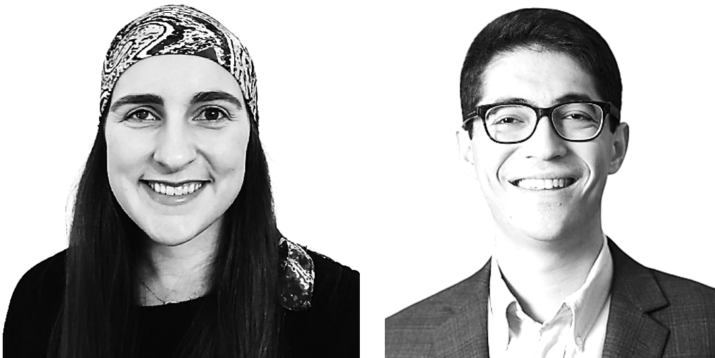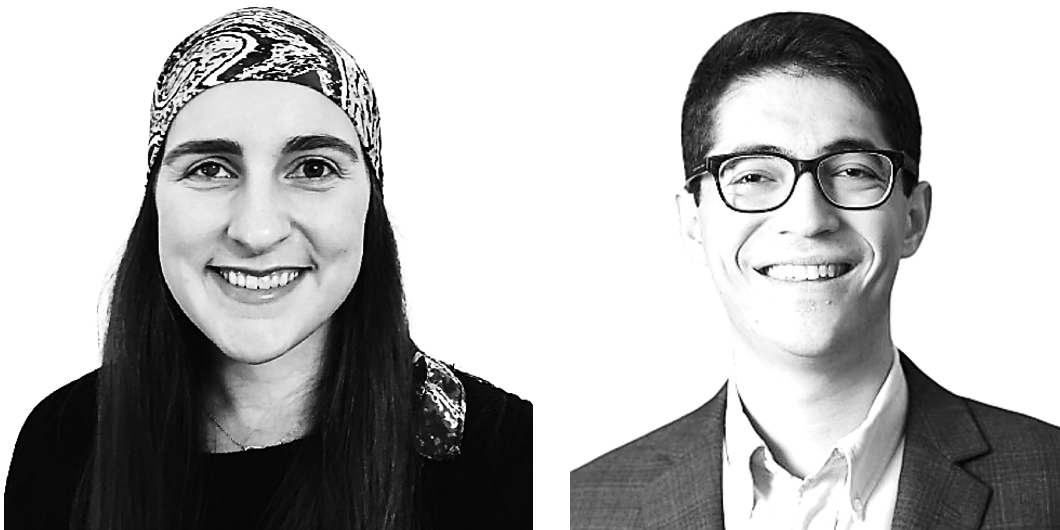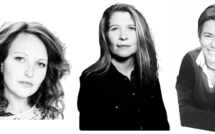
Preserving Sephardic History through Interdisciplinary Collaboration: An Interview with Makena Mezistrano and Ben Lee

An introduction to our campus spotlight on the University of Washington.
How do you preserve and celebrate a linguistic and cultural heritage that has been silenced for centuries? The answer lies somewhere between community engagement, digital humanities methods, and interdisciplinary collaboration. The Stroum Center for Jewish Studies at the University of Washington boasts thriving programs in Digital Jewish Studies and Sephardic Studies, and has become a hub for the study of Ladino (or Judeo-Spanish), a language spoken by the Sephardic community. In this interview, Makena Mezistrano (Assistant Director of the Stroum Center’s Sephardic Studies Program) and Ben Lee (PhD candidate in the Paul G. Allen School for Computer Science & Engineering at the University of Washington and former Graduate Fellow at the Stroum Center) discuss their ongoing collaborative work to make Ladino-language sources more accessible to researchers, students, and community members. They discuss their motivations and paths to becoming digital humanists, and describe the vital importance of making Ladino texts digitally accessible to scholars and the global Sephardic community. They also explain the technical challenges they face while doing so, and reflect on the value of collaborating across disciplinary lines to conduct digital humanities research.
—Taylor Soja for EuropeNow
EuropeNow To begin, can you each talk about how your initial interest in the digital humanities developed, and how you came to the field of Jewish Studies and the Stroum Center?
Makena Mezistrano As a Sephardic person myself, I have always sought representation in the field of Jewish studies, which is what led me to the University of Washington Sephardic Studies Program. We are uniquely dedicated to studying those Sephardim who spoke Ladino, or Judeo-Spanish—just like my own grandparents—after they were expelled from Spain in 1492. Working at the University of Washington has given me unparalleled access to the vast corpus of Ladino literature preserved in the Sephardic Studies Digital Collection,[1] and has afforded me the opportunity to engage with the voices and experiences of Ladino-speaking Sephardim in their own words—words that were silenced by the academy, and indeed, the world, for centuries. It’s been extremely rewarding for me to participate in recuperating the Sephardic experience at a public university: through open access digital projects, public events, and collaborations with scholars and students alike, we have created space for Sephardic studies in the university context and beyond.
In addition to my passion for the humanities, especially literature and history, I have always been interested in web and graphic design, which is how I initially came into digital humanities. I soon realized, though, that digital history was a way to meet many people at a place that feels more accessible—namely, the web—than a journal, book, or edited volume. The ability to communicate visually using photographs, newspaper clippings, maps, and more is my favorite part of creating digital exhibitions, which I have been growing acquainted with during my time here at the University of Washington.
Ben Lee Like Makena, my personal interest in the digital humanities and Jewish studies stems from my family history. My grandmother is a survivor of Auschwitz-Birkenau Concentration Camp, and I became interested in Holocaust Studies while in college. It was through Holocaust Studies research that I had my first exposure as an undergraduate to the digital humanities, which is a field near and dear to my heart. After graduating from college, I spent a year at the United States Holocaust Memorial Museum as the Digital Humanities Associate Fellow. There, I had the opportunity to explore research surrounding improving access to the International Tracing Service archive (now known as the Arolsen Archive), which is one of the world’s largest archives of materials pertaining to the Holocaust. In particular, I used machine learning to improve the searchability of the archive’s finding aid, known as the Central Name Index. It was through this project that I developed my interest in pursuing research at the intersection of machine learning and cultural heritage.
Moreover, it was at the United States Holocaust Memorial Museum that I was very fortunate to meet Devin Naar, Isaac Alhadeff Professor of Sephardic Studies and Associate Professor of History and Jewish Studies at the University of Washington, when he was invited to give a lecture. When I started at UW, Professor Naar very graciously introduced me to the Stroum Center community, and we began discussing opportunities to collaborate. Given my own research on digitized historic newspapers with Newspaper Navigator, and given the Sephardic Studies Digital Library’s incredible collection of Ladino newspapers, we realized that there was real potential to work together to improve access to Ladino newspapers with machine learning. This past academic year, I had the wonderful opportunity to serve as the Stroum Center’s Richard and Ina Willner Memorial Fellow and begin this collaboration with Professor Naar. In addition, Makena and I have been working together over the past two years to develop an online crowdsourcing transcription platform for the Sephardic Studies Digital Collection. Under our mentorship, former UW MLIS students Kristine Brady and David Heit completed a capstone project that entailed writing a detailed whitepaper that laid the foundation for this platform.
EuropeNow What is the Ladino language and how do the resources in the Stroum Center’s Sephardic Studies Digital Collection contribute to its study?
Makena Mezistrano One of the most fascinating aspects of Ladino is that it is a reflection of a global diaspora. While often characterized as a Hebrew-Spanish hybrid (hence the name “Judeo-Spanish”), Ladino developed to incorporate so many more languages depending on where Sephardim wound up post-1492, especially throughout the Ottoman Empire where many sought refuge. Elements of French, Turkish, Greek, Italian, Arabic, and more all found their way into Ladino as a result of educational trends, nationalist language reforms, and cross-cultural dialogue between Sephardim and their neighbors. Overtime, Sephardim would even take some of these multilingual words and make them their own to best fit within the unique vernacular. Even English words made their way in: Ladino newspapers from the United States in the early twentieth century include words like “downtown” rendered in Hebrew rashi letters, the script traditionally used to print in Ladino. Until the twentieth century, Ladino was always written in Hebrew characters, whether in print or in a handwritten Hebrew cursive known as soletreo, which is hardly used today. There are a host of reasons for why Hebrew character recognition declined, including shifting educational priorities both in and outside of Sephardic communities, and reforms in emergent nation states that attempted to outlaw minority languages. What this means is that many Sephardim today are cut off from their own cultural heritage; they cannot access the experiences and aspirations of their ancestors as expressed in their own words.
Our Sephardic Studies Digital Collection is the world’s largest collection of Ladino source material, and includes over 400 published Ladino books—ten percent of the entire known corpus of Ladino books ever produced—such as plays, rabbinic literature, novels, Jewish legal treatises, songbooks, biblical commentaries, and more. We have also preserved newspapers, photographs, unpublished manuscripts, postcards, immigration documents, and other important archival documents that evidence a global network of Sephardim between the Ottoman Empire, Europe, the United States, and South America. As we expand the collection, we plan to include more multimedia items beyond textual resources, such as Sephardic ballads, oral histories, and even some archival video footage of important events in the Seattle Sephardic community.
EuropeNow What roadblocks do scholars looking to utilize digitized Ladino texts face, and how does your work together at the Stroum Center solve these problems?
Makena Mezistrano So much has changed in the last twenty years about the way in which we study Sephardic history. It is hard to imagine now, but a lot of early scholarship in the United States on Sephardic history did not utilize Ladino source material, and instead relied on “outsider” perspectives, or works written in French, Turkish, or Greek, to understand the lives and experiences of Ladino-speaking Sephardim. A new generation of scholars has shown the immense value in harnessing these sources to better understand the Sephardic diaspora. But none of these sources—especially the Ladino press, which is among the most valuable resources—are electronically searchable. Scholars all over the world are thus encountering a need for more efficient electronic search tools for Ladino. The OCR technology that exists for Hebrew scripts does not yet comprehensively recognize the particularities of Ladino, which cannot be conflated with Hebrew despite being printed in similar scripts.
Ben Lee Makena and I approach the challenge of improving access to Ladino texts through two different avenues. The first is through the crowdsourcing transcription platform that we are working toward building. We see this as an opportunity not only to improve access to the collection through transcription and generate potential training data for an OCR engine, but also as an opportunity to build a community surrounding the study of Ladino texts. Seattle’s Sephardic community is vibrant, and we believe that this transcription platform could be an opportunity to bring people together. Second, my research with the Stroum Center concerns improving access to the visual content in Ladino newspapers using machine learning. The visual culture in Ladino newspapers is incredibly rich and sheds light on many aspects of Sephardic life. Though OCR may not be robust for Ladino yet, providing the ability to search over the visual content is one way of improving access and searchability for Ladino newspapers.
EuropeNow Ben, your project Newspaper Navigator[2] uses machine learning to make it possible to search visual content in digitized newspapers (such as images, headlines, advertisements), and you have worked with University of Washington Professor Devin Naar to apply the technology to the visual content in digitized Ladino newspapers.[3] What challenges have you faced in this process?
Ben Lee With Newspaper Navigator, it has been exciting to explore photographs, illustrations, comics, advertisements, and beyond in historic newspapers. The medium is strikingly visual, and the visual culture embedded within the pages is such an essential part of the experience of reading a newspaper. Ladino newspapers are no exception: they are very much meant to be consumed visually as much as textually. Given the current challenges with Ladino OCR, Professor Naar and I realized that there was an opportunity to improve access by applying Newspaper Navigator methodologies to the Sephardic Studies Digital Library and shifting our attention to the visual culture. By utilizing the Newspaper Navigator machine learning model, we were able to uncover thousands of advertisements, photographs, and beyond. In analyzing this content, we have uncovered new contours to Sephardic Jewish experiences in modernity: in addition to excavating photographs of individuals and communities, we have also identified an abundance of advertisements offering remedies for anxieties, whether medical, financial, or class-based. We hope to publicly release a dataset containing all of the extracted visual content. Moreover, I have a chapter detailing this work that is forthcoming in the book Jewish Studies in the Digital Age.[4]
The biggest technical challenge of working with the visual content of Ladino newspapers is the lack of reliable OCR. This inhibits the ability to automatedly generate textual descriptions of extracted photographs, advertisements, and beyond. It should be noted that this widespread failure of OCR engines to properly transcribe the language is an example of algorithmic marginalization: historically, OCR engines have prioritized other languages due to a host of factors, but this prioritization is, of course, deeply flawed. By making only certain digitized texts keyword searchable, OCR engines perpetuate unevenness in the historical record. I wanted to draw attention to this because it demonstrates a clear case in which machine learning-based intervention has a profound impact in the context of cultural heritage.
EuropeNow Makena, what are the goals and potential uses of this project, both for researchers and the Sephardic community? How does it compare, for instance, to some of the other online projects you have developed at the Stroum Center, such as the Sephardic Life Cycle Customs digital exhibit?[5]
Makena Mezistrano Beyond making research much more efficient for scholars, a crowdsourced transcription platform will give multiple communities the opportunity to engage with the Ladino language in an unprecedented way. Students who are learning Ladino during the current “boom” in online Ladino classes can test their knowledge by transcribing texts—a useful exercise both for advanced learners and beginners.[6] We hope that such a project will engage scholars in Israel who are proficient with Hebrew character recognition and can support our efforts, thus fortifying an international community of Sephardic studies scholars.
The Sephardic Life Cycles Exhibit is the first project of its kind to document twelve phases of the life cycle using Ladino archival material, including published books, handwritten manuscripts, photographs, and even videos—all from the former Ottoman Empire and the Pacific Northwest alike. The crowdsourced transcription project differs from Sephardic Life Cycles primarily in the technical underpinnings of the platform. Additionally, Sephardic Life Cycles has a more narrative focus that aims to engage people with Sephardic material culture by contextualizing these materials within historical and ethnographic trends, whereas the transcription platform foregrounds the Ladino language itself.
EuropeNow What role has interdisciplinary collaboration played for this project? Do you see yourselves as working across different fields/disciplines? Do you have any advice for others considering collaborating with a team on a digital humanities project?
Ben Lee Working with Makena and Professor Naar has been one of the true highlights of my time at UW. I have learned so much from their expertise and disciplinary perspectives, and I feel as though our collaborations are only possible through the excitement of all parties to learn from one another. I believe that this type of interdisciplinary work is only possible through a willingness to collaborate. Speaking from my own perspective as a computer scientist, my work in improving metadata for the Sephardic Studies Digital Library—whether through the extraction of visual content within Ladino newspapers or the development of a crowdsourcing transcription platform for Ladino documents—only reaches its true potential when the resulting metadata is properly contextualized and interpreted within the scholarship of my collaborators. It is through the expertise brought by Makena and Professor Naar that my work is brought full circle into the domain of true humanistic inquiry. For example, while doing clustering analysis of advertisements that had been reprinted within the Ladino press, I noticed an abundance of advertisements for matzos appearing within La Vara, a Ladino newspaper published out of New York. Makena had already thoroughly researched and written about these advertisements. My computational work was able to quantify the extent to which these advertisements had been reprinted, lending further credence to Makena’s findings. However, such an observation was only possible through our collaborative efforts of sharing our own findings from La Vara via research methodologies from our home disciplines.
For others considering collaborating with a team on a digital humanities project, my first advice would be to go for it. It can be intimidating at first to collaborate with scholars from different disciplines; and developing shared vocabularies and goals takes time. And yet, I have personally found this skill building to be immensely valuable, one that is often overlooked in favor of concrete project deliverables. In particular, the ability to share goals and results across disciplines helps to expand the reach of the work not only within academia but also to the general public as well. As we see an increasing shift toward digital humanities projects that engage with the public humanities in a meaningful way, these skills are proving to be even more important.
Moreover, I would say that identifying projects with thoughtful collaborators from disciplines that are canonically considered very different is enlightening and fruitful—there is much to be learned and explored in this liminal space of the digital humanities. Though there is an emphasis on the digital humanities as a space for humanists to develop computing and technical skills, it is important to note that the benefits certainly go both ways. For me personally, digital humanities research has been crucial to the development of my own interest in and understanding of critical data studies and critical computing, which in turn have informed how I approach my own computer science research writ large.
Makena Mezistrano So much of the work that needs to be done to recuperate the Ladino language requires interdisciplinary collaborations. For instance, to build library metadata for our Sephardic Studies Digital Collection, we had to create entirely new descriptive fields to account for the multiple collaborators involved in the world of Ladino book production—a world that current library standards did not sufficiently capture, but which was essential for presenting users with useful data if they are to access Ladino books on the web. Working with Ben has been extremely edifying, both because of his technical expertise and his passion for the digital humanities. It is also exciting when Ben brings his experiences from working at the Holocaust Museum and the Library of Congress to our work: He has shared valuable insights about how to engage the public in the work that we are doing through social media and other digital tools.
I think Ben and I share a commitment to building resources that are accessible to as many people as possible at multiple phases of engagement, and this shared value makes our interdisciplinary work possible. We also always keep the users in the foreground of our plans and conversations, and our respective disciplines help us imagine many different types of users, all of whom we want to benefit from our crowdsourced transcription platform. This would inform my primary advice for cross-disciplinary collaboration: even if you might not share technical knowledge (and indeed, in a successful collaboration, you likely will not), it is essential to work with people with whom you share fundamental goals about the project.
Makena Mezistrano is the Assistant Director of the Sephardic Studies Program in the University of Washington’s Stroum Center for Jewish Studies. She received her MA in Biblical and Talmudic Studies from Yeshiva University. Makena writes about Ottoman and post-Ottoman Sephardic history; her work has appeared in The Forward; Perspectives: The Magazine of the Association for Jewish Studies; and on the Sephardic Studies Program website.
Ben Lee is a fourth year PhD candidate in the Paul G. Allen School for Computer Science & Engineering at the University of Washington, where he studies human-AI interaction with his advisor, Professor Daniel Weld. He was also a 2020 Innovator in Residence at the Library of Congress, where he created Newspaper Navigator. Ben served as the 2020-2021 Richard and Ina Willner Memorial Fellow in the Stroum Center for Jewish Studies at the University of Washington, the inaugural Digital Humanities Associate Fellow at the United States Holocaust Memorial Museum, and a Visiting Fellow in Harvard’s History Department. He is currently a National Science Foundation Graduate Research Fellow in machine learning.
Taylor Soja is a PhD candidate in British and imperial history at the University of Washington, and beginning in fall 2022 Assistant Professor of History at Illinois State University. Her work has appeared in Gender & History, and her research is funded by a Mellon – Council for European Studies Dissertation Completion Fellowship. She is also committed to digital and public history, and co-directed the project Digital World Wars.
.
References
[1] https://jewishstudies.washington.edu/sephardic-studies/sephardic-studies-digital-library-museum/
[2] https://bcglee.github.io/newspaper-navigator.html
[3]https://jewishstudies.washington.edu/sephardic-studies/ladino-sephardic-newspapers-using-machine-learning-photos-illustrations-ads/
[4] Chesner, Michelle, Levi, Amalia S., Stökl Ben Ezra, Daniel, Rürup, Miriam and Zaagsma, Gerben, eds., Jewish Studies in the Digital Age (Berlin: De Gruyter Oldenbourg, 2022).
[5] https://jewishstudies.washington.edu/omeka/
[6] Paula Jacobs, “Ladino and Yiddish Classes Boom Online,” Tablet, April 11, 2021, https://www.tabletmag.com/sections/community/articles/ladino-and-yiddish-classes-boom-online. Editor’s Note: UW has taught online Ladino courses as well, see https://jewishstudies.washington.edu/sephardic-studies/inside-summer-ladino/.
Published on April 18, 2022.




